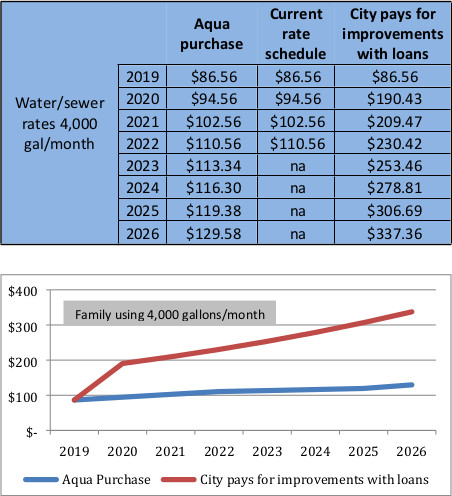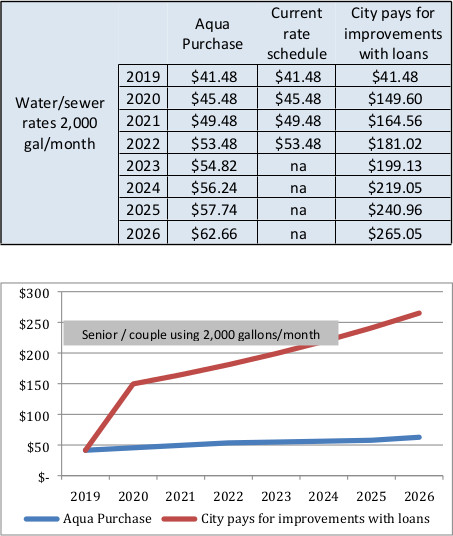St. Clairsville Water Sewer Facts
This page is designed to explain to the residents of St. Clairsville, Ohio the situation faced by the City relating to our water and wastewater (sewage) systems.
We expect to update it regularly, as the City collects new information. The newest information will be presented in bold for the ease of people returning to the page for updates.
The document is organized in two sections. The first section is a summary of key information presented chronologically with the latest information in bold at the bottom. The second section will address questions we have received from City Officials, our Bid Review Committee and the community at large.
My hope is that this page will serve as a resource for facts that will help dispel confusion and disinformation about this important issue that impacts every member of our community.
My administration and the City Council don’t have a choice when it comes to needed upgrades at our water and wastewater plants. The work must be done in the next few years, and it is going to cost approximately $25 million.
We do have a choice about how to pay for the upgrades. We can increase water bills by more than $100 a month and then compete against other Ohio communities for scarce grants and loans or, we can sell the systems to a professional utility, regulated by the Public Utilities Commission of Ohio (PUCO). The sale would involve modest, predictable rate increases, ongoing investment in the systems for reliability and compliance, and funds to support other St. Clairsville priorities.
I hope you will find this page helpful as the City discusses how to pay for the needed upgrades to our systems.
-Terry Pugh, Mayor
Background and Summary
At more than 90-years old, our water treatment plant and aging distribution system (water mains) are reaching the end of their useful lives. While our sewage treatment plant is in better shape (built in the 1980’s), the aging waste collection system that feeds the plant allows excess water into the system. This results in flooded basements (with untreated sewage) and making treatment costs skyrocket during hard rains.
The water treatment plant, water distribution system, wastewater collection system and sewage treatment plant all need to work together to keep our residents healthy and protect the environment. Treatment standards have changed significantly over the past 90 years.
The City’s finished water currently meets all health, safety and environmental requirements established by the Ohio and U.S. Environmental Protection Agencies (OEPA & USEPA). However, the plants face frequent breakdowns, and the inability to maintain systems (because of their original designs and aging components) regularly put our compliance at risk. Additionally, our aging water distribution system is responsible for discoloration, laundry stains, taste and odor frustrations throughout the community. Finally, 27% of our water mains are too small to meet modern fire protection standards.
The Ohio EPA has issued the city numerous Notices of Violation. Therefore, we must take decisive action to improve our water treatment system or face enforcement action and significant fines.
To see photos from inside the St. C water treatment plant click here.
All combined, the estimated costs to update our treatment, distribution and collection systems to modern standards exceeds $25 million. The City does not have this level of funds on hand; and, in order to qualify to compete for grants or low-interest loans for these types of projects, the City would have to more than double water and sewer bills.
To see the most recent cost estimates to rebuild the water treatment plant click here.
Note: This document includes options for expanding the water treatment plant for which there is no space and does not include costs to improve the wastewater collection systems.
To see the water and sewer rate Implications of this Issue click here.
Soon after taking office in 2016, Mayor Pugh asked his Public Services Director to identify options that meet OEPA directives and support inevitable growth in the area without excessive water rate increases.
The City has explored several options, and narrowed them to two. The first is to more than double current water bills and compete for scarce low-interest loans and even more scarce grant funding. This increase would not guarantee that we would receive assistance, only that we met the requirements to apply for help. If we received grants or loans, there is no guarantee that they would be large enough to tackle all the needs the City faces.
The second option would be for the City to partner with a professional utility company regulated by the Public Utilities Commission of Ohio (PUCO). Under this model, the operator would purchase the systems and use its capital to fund the needed updates and future improvements. For St. Clairsville, this means we could settle our existing $3.5 million utility debt. At the same time, we could also ensure our water and wastewater quality and compliance requirements are met, and that improvements could be made without skyrocketing rates.
The City administration and Council are now discussing the merits of both of these options.
Questions and Answers
How many proposals did St. Clairsville receive from regulated utilities for the purchase of the systems?
The City conducted our typical general bid process. Only one entity, Aqua Ohio, expressed interest in the form of an official proposal.
What are the highlights of the Aqua proposal?
Summary
In short, their proposal calls for more modest rate increases, ongoing investment in the systems and a one-time payment to the City of $10.6 million. The City could use these funds to retire our existing $3.5 million utility debt and start a capital projects fund to support other priorities like road repairs and solving stormwater problems (like those faced in the Belleview area). Additionally, by removing the systems from government ownership, the property would begin generating annual property taxes and other revenues that come back to our City to support our schools and community.
Proposed Rates
Aqua proposed a rate plan that uses the rate schedule already approved by our City Council though 2022. After that, they expect to increase the minimum water portion of the bill from $26.98 in 2022 to $31.23 in 2025. For the sewer portion of the bill, Aqua would use our approved rates through 2022 with NO additional increases through 2025.
Staff
Aqua would retain the City’s existing water and wastewater staff and use its team of professionals to supplement their expertise and reduce costs. As an example, Aqua Ohio has in-house engineering, customer service, communication and compliance teams to assist our local staff without the need to outsource those services saving both time and money.
How long has the City known about the problems with the water system?
The City has reports from the engineering firm Burgess and Niple outlining major problems in the systems dating back to at least June 1984. As the problems grew, that firm also submitted plans in 1987, 1988, 1999 to update and improve the system. In 2015 the engineering firm W.E. Quicksall and Associates submitted a proposal to the City’s previous administration to resolve issues at the water plant.
There may be additional reports that the current administration has not yet uncovered.
To see photos from inside the St. C water treatment plant click here.
Over the years, the City has addressed acute issues at the plants and repaired broken pipes to restore service. The sewer treatment plant was rebuilt in the 1980’s but the water treatment, distribution and sewer collection problems have never been addressed comprehensively.
What are the rate implications of the needed repairs?
The St. Clairsville Mayor and City Council are discussing how to best pay for $20 to $25 million of needed improvements to the City’s aging water and wastewater systems. An important consideration is the cost that the ratepayers would pay in either scenario.
According to the Rural Community Assistance Partnership, in order to qualify for utility repair financing, the City would need to increase rates to at least 2.5% of our median annual household income, which is $68,000. This would involve a steep increase in 2020 and regular increases thereafter.
Under a proposal from Aqua Ohio, rate increases would be significantly lower.
The table below shows the rate implications for a typical St. Clairsville family using 4,000 gallons of water per month. Note: The City Council has not passed a rate schedule for the years 2023-2026.

This table shows the rate implications for a typical St. Clairsville senior citizen using 2,000 gallons per month. Note: The City Council has not passed a rate schedule for the years 2023-2026.

How can Aqua Ohio upgrade the system without such steep rate increases?
The biggest difference is that because Aqua wouldn’t be applying for state or federal financing, there is no need to meet the requirement of rates being 2.5% of the median household income.
Another big reason a company like Aqua could avoid a big rate spike is that they are able to operate more efficiently and take advantage of economies of scale. Aqua Ohio operates 38 water and wastewater systems across the state serving approximately 500,000 Ohioans. They are able to buy materials and supplies in larger volumes and get better pricing per unit. They can also spread costs among a larger number of people. For example, if the City needs to purchase a $20,000 pump, that cost is shared among our 5,200 residents. Each resident’s burden is about $3.85. Under the Aqua model, the cost would be shared among their customers and the individual burden of that $20,000 pump would only be about $0.04.
Aqua also has another key advantage when it comes to keeping costs down. Because of its size, the company has in-house engineering, customer service, communication and compliance teams. Therefore it avoids the need to outsource those services saving both time and money.
Is it true that the company could raise rates anytime they like and what should we expect to happen to our rates after the rates quoted in the proposal through 2026?
No, Aqua does not have the ability to change rates at will. Because the company is regulated by the Public Utilities Commission of Ohio, they must request permission from the commission for any rate change. The request must justify the need for the increase and the commission conducts a thorough review of the company’s financial documentation, operational, compliance, customer satisfaction and other records. The process generally takes between nine and 12 months, and it includes a public comment period and a series of public hearings where customers are invited to testify.
While it is impossible to accurately predict rates more than seven years in advance, we can use the rates Aqua charges in its other Ohio service areas as an indicator. Some of their rates vary among jurisdictions, but their customers that have both sewer and water service and use 4,000 gallons a month are paying under $110. Among their water and wastewater systems in Central Ohio, which they purchased in 2012, monthly water / wastewater bills have increased by an average of $2.01 per year. While this is more than our residents are currently paying for service, they are considerably lower than our rates would be if the City was to pay for the improvements using loans.
How can we be confident that Aqua Ohio would invest in our infrastructure and not let the system that serves St. Clairsville get worse?
Aqua has a strong track record of investing in its systems for compliance and reliability. They typically invest between $30 and $40 million per year in its 38 Ohio systems. In 2019 Aqua is spending $44 million on water and wastewater improvement projects.
City staff is working on answers to other questions relating to this issue that have been presented over the past several weeks.
We encourage residents to check back regularly. New information is presented in bold font.